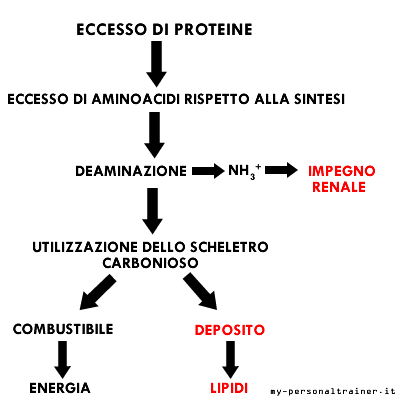The high-protein diet is a particular diet characterized by a reduced consumption of carbohydrates combined with a high intake of proteins and fats.
Before analyzing the strengths and weaknesses of the high-protein diet, it is good to open a little parenthesis on proteins and their function in our body:
proteins or protides (from the Greek proteios, "primary") comprise a large group of organic compounds formed by sequences of amino acids linked together through peptide bonds.
The main function of proteins is to supply the tissues with the amino acids necessary for cell renewal processes (plastic function).
In particular conditions, proteins also have an energy function, but in a balanced diet this role is marginal. Instead, this process is active during prolonged fasting or in the midst of a demanding physical activity of long duration. In both cases the branched-chain amino acids (leucine, isoleucine, valine) are degraded for energy purposes.
RECOMMENDED DAILY NEED
Nutritionists recommend consuming a quantity of protein equal to about 15-20% of the daily caloric intake throughout the day. This dose roughly corresponds to a protein intake of 0,8-1,2 g of protein per kg of body weight. To ensure the correct functioning of the organism and protect it from certain diseases, 2/3 of these proteins should derive from products of animal origin and 1/3 from products of vegetable origin (legumes). In fact, legumes are foods rich in fiber and vitamins that regulate intestinal function while protecting the body from toxins and chemical residues, often contained in meat.
The high-protein diet, on the other hand, provides for significantly higher intakes in the order of 1,8-2,2 g / kg.
EXCESS PROTEIN IN THE DIET: DISADVANTAGES OF THE HYPERPROTEIC DIET
As we can see from the diagram in the figure, the consequences of an excessive consumption of proteins depend on the total amount of energy introduced during the day.

In particular, if the quantity of calories consumed in the form of carbohydrates and lipids is sufficient to cover the energy requirements, the excess of proteins inevitably transforms into storage fat (high-protein and high-calorie diet).
If the amount of energy consumed in the form of carbohydrates and lipids is not sufficient to cover the energy requirements, the excess protein is instead used to obtain energy (low-calorie high-protein diet).
In any case, both processes lead to an increased renal effort necessary for the elimination of the nitrogen contained in the proteins. For this reason it is very important to always associate an adequate supply of water (minimum two liters per day) with a high-protein diet.
ADVANTAGES OF THE HYPERPROTEIC AND HYPOCHALORIC DIET
A diet rich in proteins keeps insulin levels constant, increases basal metabolism, stimulates lipolysis and consequently weight loss.
A high-protein diet promotes the secretion of anabolic hormones such as testosterone and GH. This effect is especially important for those who practice power sports (rugby, weightlifting, sprint competitions, bodybuilding, etc.). These athletes are among the biggest supporters of high-protein diets.
Indeed, such a diet has some effectiveness in promoting the increase in muscle mass and the reduction of body fat. To protect one's health, however, it is important that hyperproteinity is only one aspect of the diet and that the concept is not taken to extremes. In fact, all diets that take a particular concept to the extreme hide negative implications. For this reason we have tried to summarize the characteristic points of the high-protein diet by revisiting them in a healthy way:
before embarking on a new dietary regimen, consult a specialized doctor to make sure there are no contraindications. The high-protein diet is contraindicated especially in the case of liver and kidney problems (renal failure, diabetic nephropathy, etc.). However, it is not suitable for those who practice endurance sports such as running or cycling. Limit the consumption of simple sugars (sugar, sweets, sugary drinks, etc.) and more generally of foods with a high glycemic index (especially in the evening). Limit the consumption of bread, pasta, rice and cereals in general by avoiding combining them within the same meal. Instead, go for fruit and vegetables, raw or steamed, preferably in season. Increase the consumption of proteins and fats in the diet while respecting the following rules: |
prefer white meat (chicken, turkey, rabbit) to red meat (beef, pork), but don't completely exclude the latter from your diet. Reduce the consumption of fatty cheeses and prefer "lean" ones such as Piedmontese ricotta, mozzarella, certosino, robiola, crescenza, cottage cheese. Limit the consumption of sausages and preserved meat, especially the fatty one and the one in which nitrites appear among the ingredients (E249 E250). Never skip breakfast or snacks At least 3 times a week, replace meat with fish. At least 3 times a week, replace meat with legumes. To increase the intake of fat in the diet, increase the consumption of dried fruit, accompanying it with a fruit during snacks. Season the dishes with olive oil without demonizing the butter, eggs and saturated fats in general (for example yogurt does not necessarily have to be lean, it is better to avoid fruit, often too rich in sugar). Avoid consuming "trans" or hydrogenated fatty acids (found in margarine, peanut butter, and many baked foods that contain them). However, the protein intake should not exceed 1,8-2 grams / kg of body weight or 18-22% of the daily energy intake. However, the proportion of fat in the diet should not exceed 40-45% of the daily energy intake. |
See also: Example 2000 calorie high protein diet
Excess protein in the diet
How much protein in a balanced diet
Ketogenic diet? No thanks!
Proteins
The metabolic diet


























